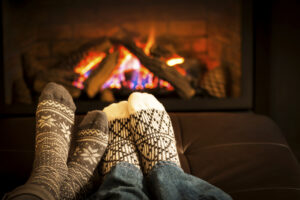 Your fireplace provides your home with a number of positive benefits, including style, warmth, and convenience. On those cold winter days and nights, there is nothing like snuggling up to the warmth of the crackling fireplace. As wonderful as your fireplace may be, there are a number of potential safety risks that can turn your fireplace into a source of serious danger to you, your family and your entire home.
Your fireplace provides your home with a number of positive benefits, including style, warmth, and convenience. On those cold winter days and nights, there is nothing like snuggling up to the warmth of the crackling fireplace. As wonderful as your fireplace may be, there are a number of potential safety risks that can turn your fireplace into a source of serious danger to you, your family and your entire home.
In order to maintain the safety of your fireplace, here are the top 10 fireplace safety tips.
1. Don’t Use Your Fireplace For Too Long
Your fireplace is not a furnace and shouldn’t be used as such. In other words, don’t use your fireplace for longer than five hours at a time.
2. Screen Closed, Glass Open
Keep the glass covering on your fireplace open so that air has the chance to flow upwards into the chimney to help cool it down. This airflow is also important in order to help prevent the buildup of creosote, a sticky substance that builds up along the inner walls of your chimney and increases your risk for a chimney fire.
Keep the screen closed to prevent hot sparks from escaping the fireplace and landing on the carpet, pets or people. You can also purchase a nonflammable rug to place directly in front of your fireplace, this helps prevent ruining your real carpeting or flooring in the instance a hot ember finds a way to escape.
3. Make Sure Your Chimney Cap Is Secure
A chimney cap is an incredibly important component of your fireplace. Unfortunately, it is often forgotten because of its location atop your home. A chimney cap prevents animals from building a nest on your chimney. If animals successfully build a nest on top of your chimney, debris and smoke will become blocked from escaping as they are supposed to. If debris can’t escape through the top of your chimney they will flow back into your home, exposing your family to carbon monoxide and other toxins.
Chimney caps also prevent water damage. Without a chimney cap, water from rain or snow can leak inside of your chimney and create unseen damage that contributes to additional risks.
4. Regularly Clean Out Your Firebox
The firebox, or the area used to burn logs, should be cleaned out about once a week during the months your fireplace gets the most use. As soon as you notice a build up of ash it is time to grab your fireplace cleaning tools. You should leave about one-inch of ash at the bottom of the firebox in order to help future coals heat up quicker and retain heat with greater efficiency. When your fireplace is not in use, completely clean out all ash.
Fireplace coals can retain enough heat to reactivate sparks up to three days after the last active fire. This is why it’s recommended to wait at least three days before cleaning out your fireplace.
5. Burn Clean Logs
Don’t use just anything to start a fire. Properly dried, clean logs are the best bet for safe fires. You want to avoid moist and soft wood, which will increase the amount of creosote produced. When it comes to sparking a fire in your fireplace, flammable liquids, trash, debris and cardboard boxes should all be avoided as well.
6. Open A Window
After starting a fire it’s important to open a nearby window to prevent smoke accumulation in your home. If you use an unvented gas fireplace it is even more important to keep at least one window open to promote necessary air circulation.
7. Install and Maintain Smoke Detectors
You should never leave a burning fire unattended, but even if you plan to monitor your fireplace whenever it’s in use, it’s important to have a backup system in place. Smoke detectors should be installed throughout your home to prevent the risk of a fire going unnoticed. Smoke detectors will also alert you to unsafe levels of carbon monoxide, which may flow back into your home if your chimney isn’t properly working to filter out toxins.
8. Keep Children And Pets Away From The Fireplace
Children and pets are at the greatest risk for becoming burned by an active fireplace. Keep a watchful eye on them at all times when they are around the fire. Adding a childproof (and animal-proof) gate in front of your fireplace is a great option.
9. Keep Area Around Fireplace Clean
The mantel and surrounding area near your fireplace should always be free of debris and combustible materials.
10. Fireplace Maintenance
Have a professional out to check over your fireplace every year before the start of the cold season. The first few times you put your fireplace to use every winter present the greatest risk for danger. By having your fireplace checked out you can prevent many dangerous scenarios from sparking.
You can count on Turnbull Masonry to keep you and your family safe 365-days a year!
